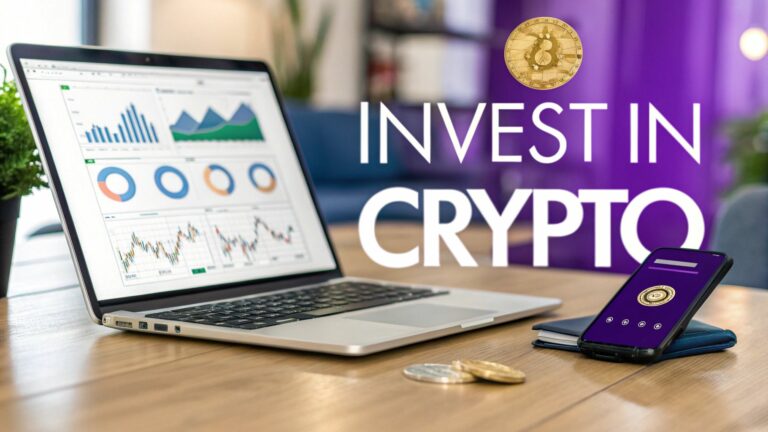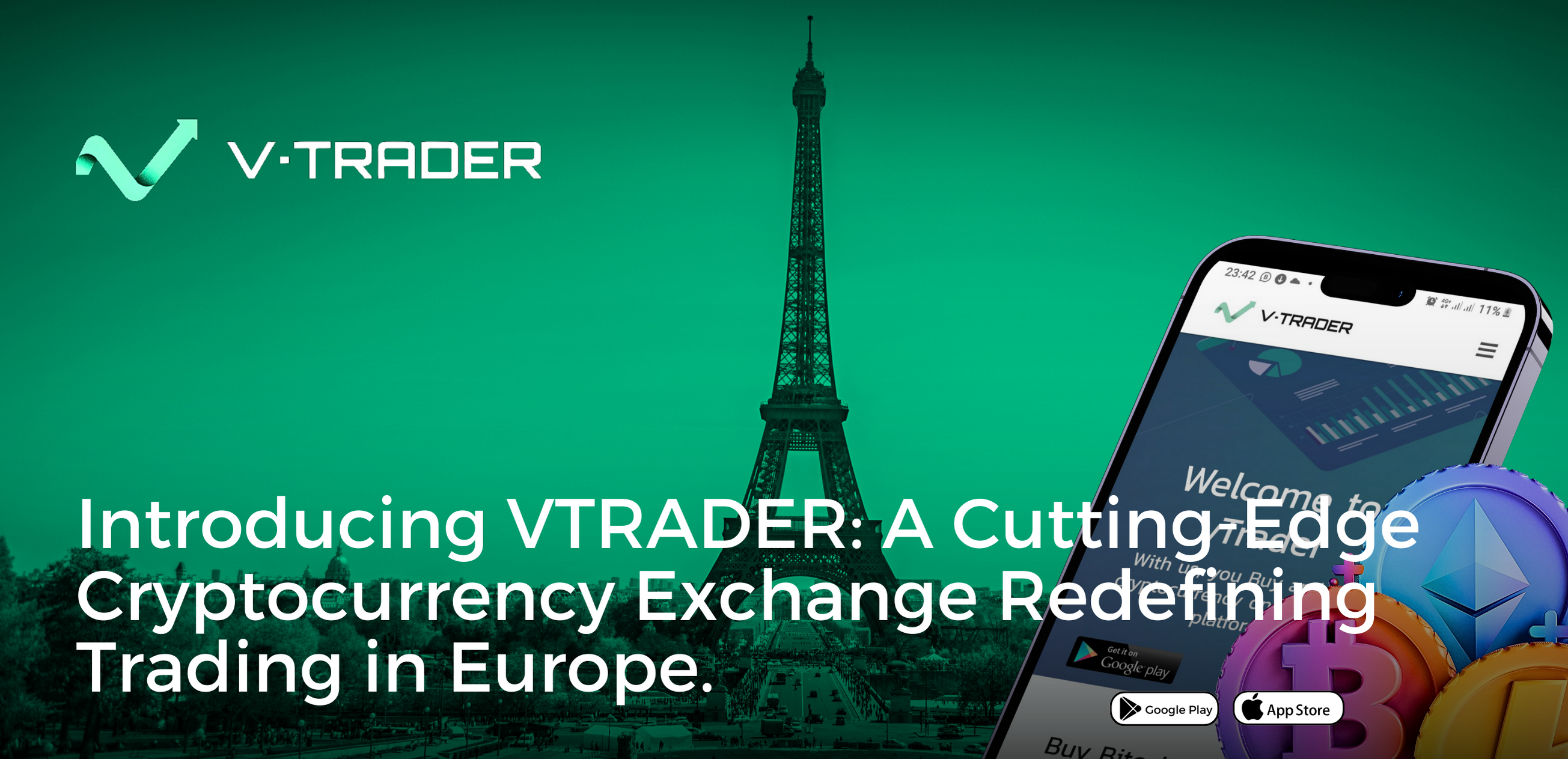Thinking about investing in crypto can feel like standing at the bottom of a mountain. But getting to the top is a lot simpler than it looks. The short answer to "how do I start?" is pretty straightforward: choose a trusted platform, create an account, add some funds, and buy your first asset.
This guide will break that all down, showing you exactly how to do it securely and simply with vTrader.
Your First Steps into Crypto Investing
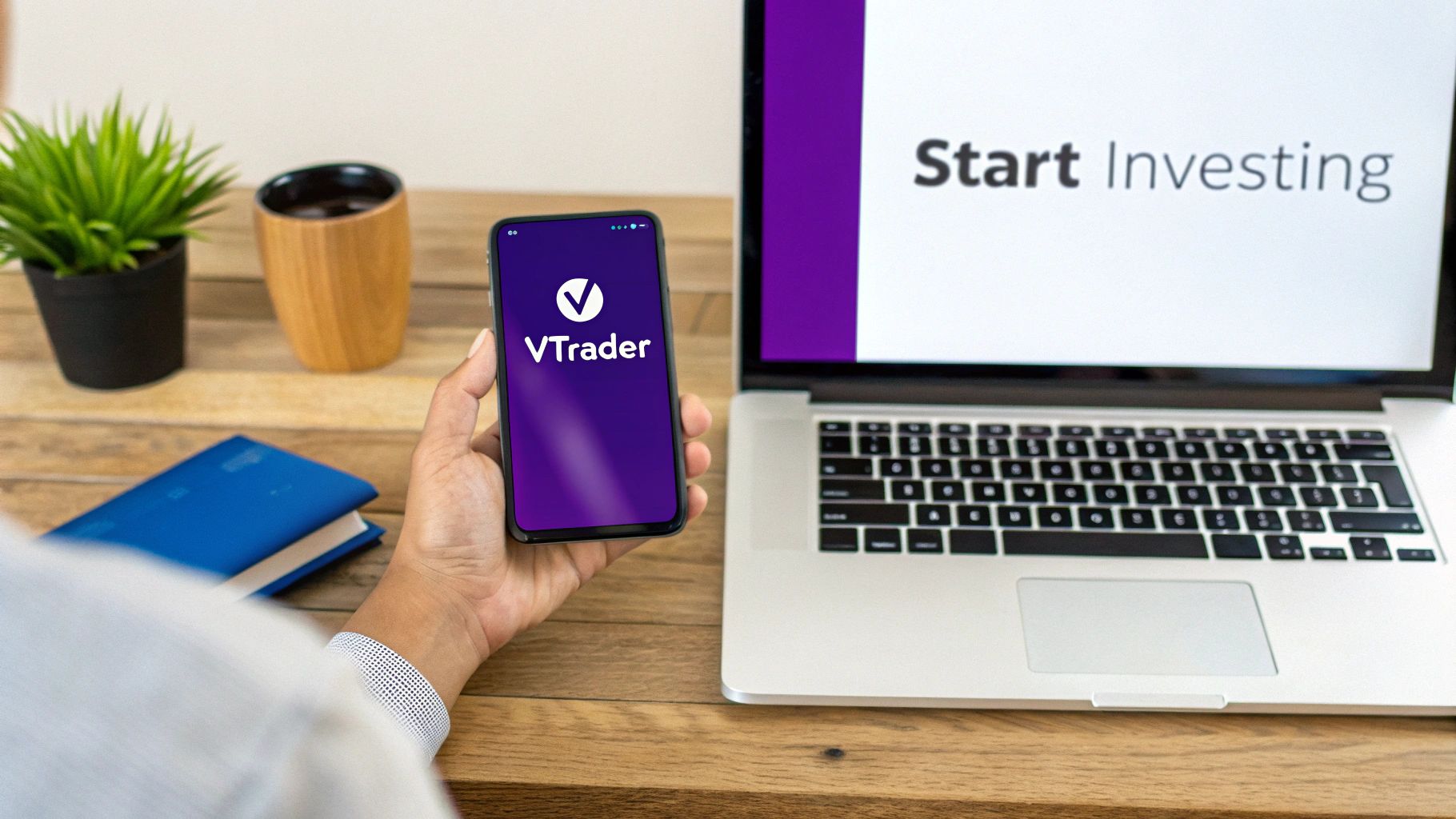
Your journey into crypto really begins with one key decision: picking the right platform. Think of a crypto exchange as your digital bank and brokerage all in one. It’s the place where you'll swap traditional money (like US dollars) for digital assets like Bitcoin or Ethereum.
The platform you choose really does shape your entire experience. A user-friendly, secure, and fee-free exchange like vTrader can be the difference between a confident start and a frustrating one. Sneaky fees can eat into your potential returns over time, which is why vTrader’s commission-free model is such a game-changer for new and seasoned investors.
Understanding the Core Concepts
Before you jump in, it helps to get a handle on a few basics without getting bogged down in technical jargon. If you're just starting, a solid primer on What Is Cryptocurrency can clear things up fast, explaining how these digital assets work in simple terms.
Here are the key ideas to have in your back pocket:
- Cryptocurrency Exchange: This is just a marketplace where you can buy, sell, and trade crypto. vTrader is an exchange built to be easy enough for beginners but powerful enough for pros.
- Digital Wallet: This is where your crypto lives. Exchanges like vTrader provide a "custodial" wallet, which means they handle all the complex security for you.
- Market Volatility: Crypto prices move—a lot. It's a high-risk, high-reward environment, and it's something every investor needs to be comfortable with from day one.
To make things even clearer, here's a quick table to guide your first moves.
Quick Start Your Crypto Investment Journey
This table breaks down the essential steps and highlights what you should be thinking about as you get started on vTrader. It’s your cheat sheet for a smooth entry into the market.
| Action | Key Consideration | Why It Matters for You |
|---|---|---|
| Choose Your Platform | Look for security, zero fees, and ease of use. | A good platform protects your assets and maximizes your returns. |
| Create Your Account | Use a strong, unique password and enable 2FA. | Your account security is non-negotiable. |
| Fund Your Account | Link a bank account or use another supported method. | You need to get your "fiat" money in to buy crypto. |
| Make Your First Buy | Start small to get a feel for the process. | This builds confidence without exposing you to major risk. |
Following these steps will put you on the right path, but remember, the journey doesn't end after your first purchase. Continuous learning is key.
Your Roadmap to Investing with Confidence
Think of this guide as your roadmap. We’re going to walk through each part of the process so you feel prepared and informed. You won't just learn what to do, but why each step is crucial for your financial security and success.
The most important part of learning how to invest in crypto is building a solid foundation of knowledge. Rushing in without understanding the basics is one of the biggest mistakes new investors make.
We're big believers that education is the key to smart investing. That’s why we built the vTrader Academy—a hub full of free resources and tutorials to deepen your understanding. This is all about building confidence, and we’re here to help you do it right.
Setting Up Your vTrader Account for Secure Investing
Before you can make your first trade, you need a secure place to operate from. Setting up your vTrader account is that critical first step, but it’s about a lot more than just choosing a username. Think of it as building the vault before you fill it with anything valuable.
The initial sign-up is pretty quick, but the most important steps come right after. These are the security layers that will shield your assets from the ever-present threat of fraud and digital thieves.
Why Identity Verification Is Essential
One of the first things vTrader will ask you to do is complete a Know Your Customer (KYC) check. This means you’ll need to verify your identity, usually with a government-issued ID and sometimes a quick selfie. It might feel like a bit of a hassle, but this is one of the most important security features a serious trading platform can offer.
Here’s why it matters so much:
- It protects you directly. By confirming you are who you say you are, vTrader makes sure no one else can open an account in your name and cause trouble.
- It keeps bad actors out. This process is a huge roadblock for criminals trying to use financial platforms for illegal activities.
- It ensures regulatory compliance. As a FinCEN-registered company, we follow federal rules designed to make the financial system safer for everyone.
Platforms that skip KYC often become magnets for scams. Getting this step done is your first line of defense, making sure your account and your funds are tied directly to you, and only you.
Fortifying Your Account with Multi-Factor Authentication
Once your identity is confirmed, the next thing you should do—no exceptions—is enable Multi-Factor Authentication (MFA). You might know it as two-factor authentication (2FA). This single action gives your account’s security a massive boost.
Instead of just needing a password to log in, MFA requires a second piece of proof, typically a temporary code from an app on your phone.
Imagine a hacker manages to steal your password. Without MFA, they’re in. But with MFA enabled, they’re stopped cold. They don't have your phone to get that time-sensitive code, so they hit a brick wall.
A strong password is like a good lock on your door, but MFA is the alarm system. It’s an absolute must-have for protecting your digital assets.
Setting this up on vTrader is simple. You’ll use an authenticator app like Google Authenticator or Authy. Just scan a QR code from your vTrader account, and the app will start generating new six-digit codes every 30 seconds. It's a small habit that makes your account exponentially harder for anyone else to get into.
Creating Passwords That Actually Work
We’ve all been told to use "strong" passwords, but what does that really mean? A weak password can make all your other security efforts pointless. I’ve seen it happen: an investor reused a password from another website that got breached. A hacker took that leaked password, tried it on their crypto account, and drained it in minutes.
This isn't some rare, complex hack; it's an everyday tactic. To avoid becoming a statistic, here’s what you actually need to do:
- Think longer, not just weirder. A short, complex password like
Tr@d3r!is actually weaker than a longer passphrase likeMy-Gr33n-Car-Drives-F@st!. The second one is far tougher for a computer to guess but much easier for you to remember. - Use a password manager. Stop trying to memorize dozens of unique passwords. Tools like Bitwarden or 1Password create and save incredibly strong, unique passwords for every site you use. You just need to remember your one master password.
- Never, ever reuse passwords. Every single account—email, social media, banking, and especially crypto—needs its own unique password. That way, if one account is compromised in a data breach, the damage doesn't spread to your other ones.
When you combine a long, unique password with MFA, you’re building a serious security wall around your vTrader account. These first few steps aren't just about getting ready to invest; they’re about giving you the peace of mind to focus on your strategy, knowing your assets are protected from day one.
Funding Your Account and Making Your First Purchase
Alright, your vTrader account is set up and secure. Now for the fun part: getting some funds in there and making your first crypto purchase. This is where you go from spectator to participant.
Getting money into your account is straightforward, but you’ve got a couple of choices. Each has its own pros and cons, mostly boiling down to speed versus convenience.
Choosing Your Funding Method
The two main ways to deposit money into your vTrader account are a direct bank transfer (ACH) or using your debit card.
- Bank Transfer (ACH): This is usually the go-to for larger amounts. You just link your bank account directly to vTrader. The funds might take a business day or two to show up, but it's a solid, reliable method.
- Debit Card: This is your fast pass. Using a debit card means the funds are available pretty much instantly, so you can jump on a market opportunity in minutes. Perfect for when you don't want to wait.
We're big on transparency here at vTrader. Unlike a lot of platforms that sneak in extra charges for card transactions, we keep it simple. You can see our entire approach to funding and withdrawals by checking out our fee schedule information. No surprises.
This infographic is a great recap of the security steps you just took—all of which are essential for protecting your investments from day one.
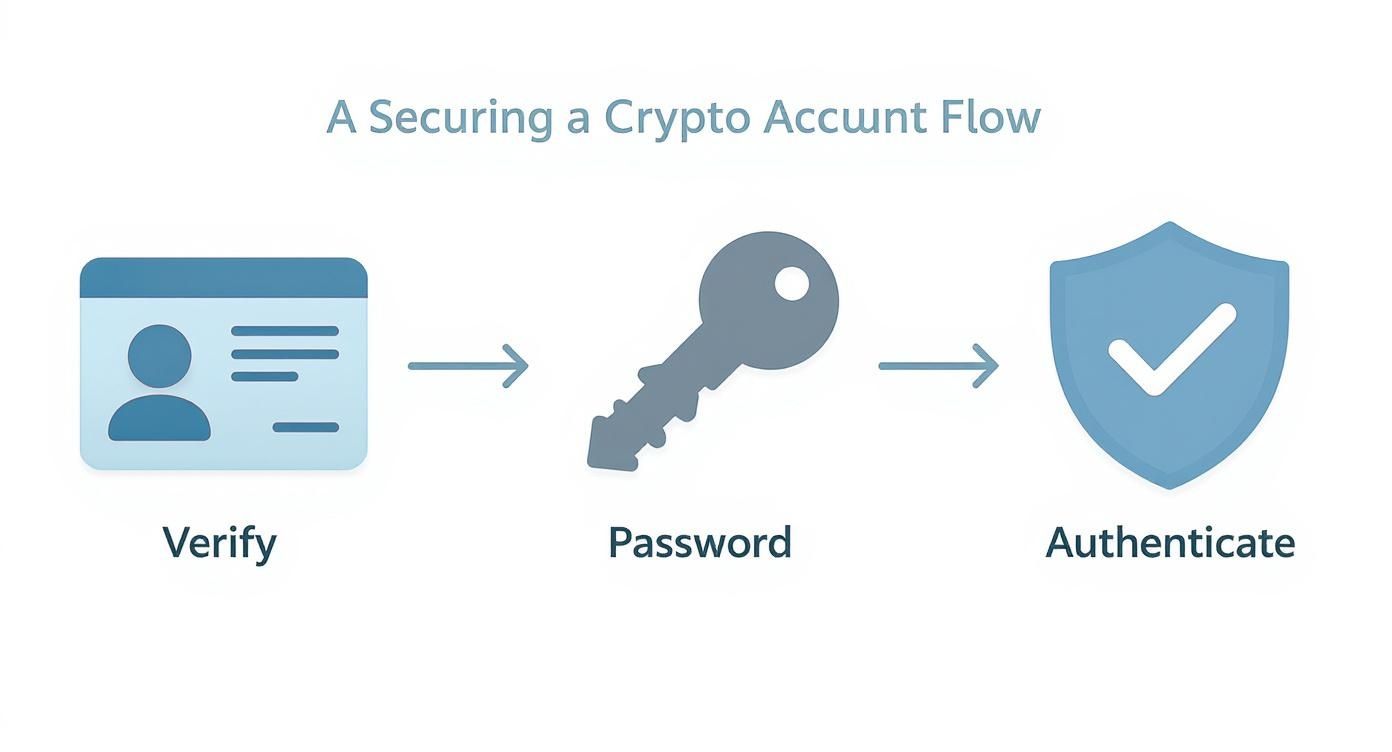
By verifying your identity and turning on multi-factor authentication, you've built a strong defense for your account.
A Practical Example: Buying Your First Bitcoin
Let's walk through a real-world scenario. You've decided to start small and invest $100. You've already linked your bank account and the transfer has cleared. Now, you’re ready to get your hands on some Bitcoin (BTC).
Fire up the vTrader app or website and head to the Bitcoin trading page. You'll see the live price, a chart of its recent action, and a simple order form. This is where you'll run into two basic order types that every trader needs to know.
Understanding Market Orders vs. Limit Orders
The type of order you place dictates how your purchase goes through. Getting this right is a fundamental skill for any crypto investor.
Market Order
A market order is the simplest way to buy. It's you telling the exchange, "Get me $100 worth of Bitcoin right now at whatever the best price is."
- Pro: It's fast. Your order gets filled immediately.
- Con: You give up control over the exact price. In a volatile market, the price can tick up or down in the seconds between you hitting "buy" and the trade actually executing.
For a $100 purchase, a market order is perfectly fine. It's what most newcomers use to get their foot in the door.
Limit Order
A limit order puts you in the driver's seat. You're telling the exchange, "Buy me $100 of Bitcoin, but only if the price hits my target price or lower."
- Pro: You name your price. This ensures you never pay more than you're willing to.
- Con: Your order might never get filled. If the market price never drops to your limit, you'll be left on the sidelines.
Expert Tip: A popular strategy is to set a limit order just below the current market price to try and catch a small dip. If Bitcoin is trading at $60,000, you could set a limit buy for $59,500.
Starting with an asset like Bitcoin is a common and sensible move. The sheer volume speaks for itself; in Q3 2025 alone, top exchanges processed a staggering $5.1 trillion in spot trading. Even with thousands of coins out there, Bitcoin and Ethereum dominate, accounting for nearly 75% of the total crypto market cap.
Once your order is placed and filled, that's it—congratulations, you're officially a crypto investor. You'll see your new Bitcoin holdings in your vTrader portfolio, ready for you to hold, trade, or manage however you see fit.
Building and Managing Your Crypto Portfolio
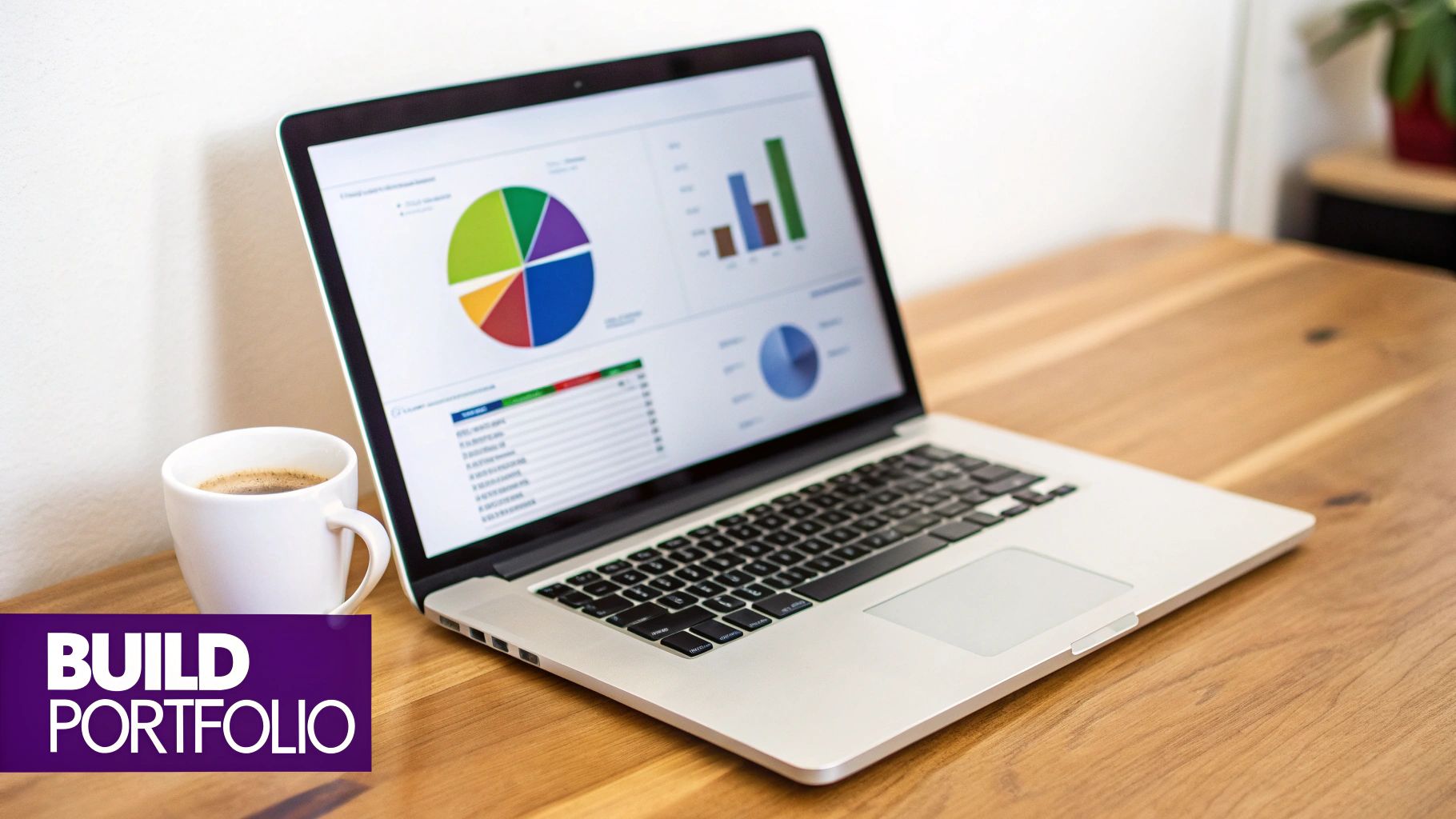
Making your first crypto purchase is a huge step, but it’s just the beginning. The real work—and the real fun—starts now. This is where you graduate from simply buying a coin to actually building a thoughtful portfolio.
A solid portfolio isn't just a random grab bag of trending coins. It’s a balanced mix of different assets that work together. I like to think of it like building a sports team—you need your reliable star players, a few high-potential rookies, and a strong defense to protect your lead.
Balancing Your Core Holdings with Growth Potential
The foundation of any good crypto portfolio should be built on the big, established players. For nearly everyone, that means starting with Bitcoin (BTC) and Ethereum (ETH).
- Bitcoin (BTC): This is "digital gold" for a reason. Most investors see it as a long-term store of value. As the original and most decentralized crypto, it acts as a relatively low-risk anchor for your portfolio.
- Ethereum (ETH): Far more than just a currency, Ethereum is a massive platform for building decentralized apps (dApps). Its value is tied to the growth of Web3 technology, giving it a completely different kind of potential than Bitcoin.
These two provide a baseline of stability in a market known for its wild swings. Once you have that core in place, you can start digging into altcoins—basically, any crypto that isn't Bitcoin. Altcoins carry more risk, but they also offer the potential for much faster growth. To get more advanced, you can explore some of the best crypto trading strategies for managing these different asset types.
A Practical Beginner Portfolio Example
Let's say you're starting with $500. A smart, beginner-friendly allocation on vTrader might look something like this:
| Asset | Allocation | Dollar Amount | Role in Portfolio |
|---|---|---|---|
| Bitcoin | 50% | $250 | The stable foundation and store of value. |
| Ethereum | 30% | $150 | A mix of stability and tech-driven growth. |
| Altcoins | 10% | $50 | Higher-risk assets for potential high returns. |
| Stablecoins | 10% | $50 | Your defensive layer for managing volatility. |
This is just a template, not gospel. Your personal risk tolerance and goals should always be your guide. With vTrader's dashboard, you can easily track these allocations in real-time and explore different cryptocurrencies to see what might be a good fit for your strategy.
Automating Your Investments with Dollar Cost Averaging
One of the most effective and least stressful ways to build a position in crypto is Dollar-Cost Averaging (DCA). It’s simple: you invest a fixed amount of money at regular intervals, no matter what the price is doing.
Instead of dropping $400 all at once, you could set up a recurring buy on vTrader for $100 worth of Bitcoin every Monday. When the price is high, your money buys less. When the price dips, it buys more. This approach smooths out your average entry price and saves you from the anxiety of trying to time the market perfectly.
Setting up a recurring buy is one of the smartest moves a new investor can make. It removes emotion from the equation and builds your portfolio consistently, turning market volatility into an advantage.
The Crucial Role of Stablecoins
Finally, let's talk about defense. Stablecoins are crypto assets pegged to a stable asset, usually the U.S. dollar. Coins like USD Coin (USDC) are designed to always be worth around $1.00.
They serve two critical purposes:
- A Safe Haven: When the market gets choppy, you can move some of your crypto into USDC to lock in gains without having to cash out to your bank account.
- Dry Powder: Keeping some funds in stablecoins means you’re always ready to buy the dip when opportunities pop up.
Stablecoins have quietly become a cornerstone of the crypto economy. They’re a pro-level tool that any beginner can easily use on vTrader to manage risk and stay ready for the next move.
Developing a Long Term Crypto Investment Mindset
Making it in crypto has a lot more to do with your mindset than you might realize. Sure, the first steps are mechanical—opening an account, making a deposit, buying your first coin. But what separates successful long-term investors from everyone else comes down to mastering the psychology of the market.
It's about shifting your focus from the sugar rush of a daily price chart to the quiet discipline of building real wealth.
Crypto is famous for its wild swings, with breathtaking rallies often followed by stomach-churning drops. If you don't have the right headspace, it’s all too easy to let your emotions take the wheel. You might panic-sell at the bottom or, even worse, FOMO into a hot coin right at its peak. A long-term perspective is your anchor, helping you filter out the noise and stick to your game plan.
Embracing Self Custody When It Makes Sense
Once you start accumulating a decent portfolio, you’ll run into the old crypto saying: "Not your keys, not your coins." This gets at the heart of self-custody—the idea of moving your crypto off an exchange like vTrader and into a personal hardware wallet that only you control.
For anyone just starting, keeping your crypto on a secure, regulated exchange like vTrader is absolutely the way to go. We handle all the heavy lifting on security. But as your holdings grow into a significant chunk of your net worth, it's smart to consider self-custody for the assets you plan to hold for the long haul.
Here's a good way to think about it: vTrader is your ultra-secure bank account, perfect for active trading and easy access. A hardware wallet is your personal vault at home, where you keep the crown jewels. You can hold your "cold storage" assets there while keeping a smaller, active portion on the exchange.
Navigating Market Swings with a Cool Head
The real test of an investor is discipline. When the market is down 30%, your gut screams at you to sell and cut your losses. When a coin is rocketing upwards, the urge to throw every last dollar at it is almost unbearable.
This is where seasoned investors make their money—by staying disciplined when others are losing their heads.
A few tips from the trenches:
- Have a Plan Before the Storm: Decide why you're investing and what your goals are before things get crazy. Know your thesis for each asset and what would actually need to happen for you to change your mind.
- Zoom Out: Don't get hypnotized by the 5-minute chart. Pull back and look at the weekly, monthly, and even yearly trends. It gives you a much healthier perspective on what's really happening.
- Stop Checking Your Phone: Obsessively refreshing your portfolio is a recipe for anxiety. Pick a time to check it once or twice a day, and then leave it alone.
Staying calm when everyone else is panicking is one of the hardest—and most profitable—skills you can build. Big market corrections are just part of the game. For those with a long-term view, they are often the best buying opportunities in disguise.
Putting Your Crypto to Work with Staking
A long-term strategy isn't just about holding on for dear life (HODLing). It's also about making your assets work for you. One of the best ways to do this is through staking, which lets you earn rewards just for holding certain cryptocurrencies.
Think of it like a high-yield savings account for your crypto. By "locking up" your coins, you help secure the network. In return for your contribution, the network pays you rewards, usually in the form of more coins.
Staking lets you passively grow your stack, compounding your gains over time without needing to actively trade. It's an incredibly powerful tool for anyone focused on building wealth for the future. You can learn more about how staking on vTrader works and see which assets are available to start earning today. It’s a perfect fit for a "set it and forget it" approach.
The rise of strategies like staking shows just how much the market is growing up. We're past the early days. As of 2025, nearly a quarter (24%) of adults across major global markets now own crypto. This isn't a niche hobby anymore; it's a mainstream financial reality. For more on this, check out the 2025 Global State of Crypto Report.
Common Questions About Crypto Investing
Even with a solid plan, you're going to have questions when you first jump into crypto. That’s perfectly normal. Getting straight answers is the best way to build the confidence you need to invest smartly.
Here are a few of the most common questions we hear from people just getting started. Let's clear them up.
How Much Money Do I Need to Start?
There's a persistent myth that you need thousands of dollars or have to buy a whole Bitcoin to get in the game. That’s just not true anymore.
With modern platforms like vTrader, you can get started with as little as $10 or $20. This is all thanks to fractional investing, which lets you buy a tiny piece of a coin. The most important rule here is to only invest what you're genuinely comfortable losing. This isn't just a throwaway line; it's the core principle that will save you from making emotional decisions when the market gets choppy.
A lot of beginners swear by dollar-cost averaging (DCA). It's simple: you invest a small, fixed amount on a regular schedule, like $25 a week. This strategy helps average out your purchase price over time, so you're not trying to perfectly "time the market."
It’s a great way to build a position without the stress.
Is It Safe to Keep My Crypto on an Exchange?
For most people starting out, a reputable, regulated exchange like vTrader is a very secure place for your assets. We rely on top-tier security measures like cold storage—which means we keep assets offline, far away from hackers—and carry insurance to protect user funds.
You’ll hear some crypto veterans say, "not your keys, not your coins," advocating for self-custody. While that gives you ultimate control, it also comes with huge personal risk. If you lose your private keys, your crypto is gone forever. No one can get it back for you.
A trusted exchange offers a practical balance between world-class security and convenience. As your portfolio grows, you might explore moving long-term holdings to a hardware wallet, but keeping your active trading funds on an exchange is standard practice. For a deeper dive, our extensive FAQ page offers further insights into our security protocols.
How Are My Crypto Investments Taxed?
This is a big one. In most places, including the United States, crypto is treated as property for tax purposes. You have to understand what this means: you’ll likely owe capital gains tax anytime you sell, trade, or even spend your crypto for a profit.
Here’s how it usually works:
- Long-Term Capital Gains: Hold an asset for more than one year before selling, and you generally pay a lower tax rate on the profits.
- Short-Term Capital Gains: Hold it for less than a year, and the profit gets taxed at your regular income tax rate, which is almost always higher.
You absolutely must keep good records of every single transaction—buys, sells, and trades. The good news is that platforms like vTrader usually provide downloadable tax reports that make this way easier.
Keep in mind, tax laws are complicated and can change. For example, the Tax Cuts and Jobs Act of 2017 temporarily changed the rules around deducting losses from personal theft, which affected victims of some crypto scams. The IRS later clarified the rules for investment-focused scams, but it just goes to show how complex this stuff is. It's always a good idea to talk to a qualified tax professional who can give you advice based on your specific situation.
Ready to start your crypto journey with confidence? Join vTrader today to experience secure, fee-free trading. Sign up now and get a $10 bonus to kickstart your portfolio. Begin investing the smart way at https://www.vtrader.io.

Steve Gregory is a lawyer in the United States who specializes in licensing for cryptocurrency companies and products. Steve began his career as an attorney in 2015 but made the switch to working in cryptocurrency full time shortly after joining the original team at Gemini Trust Company, an early cryptocurrency exchange based in New York City. Steve then joined CEX.io and was able to launch their regulated US-based cryptocurrency. Steve then went on to become the CEO at currency.com when he ran for four years and was able to lead currency.com to being fully acquired in 2025.
